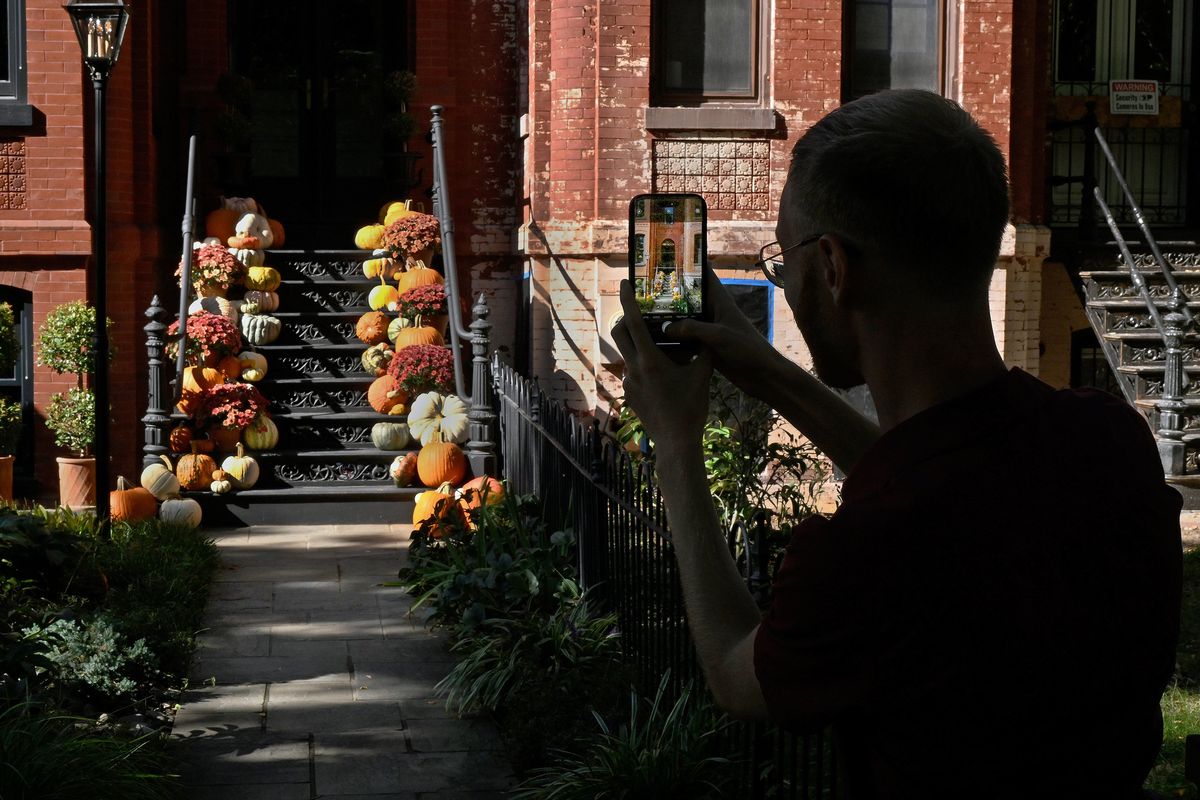It’s decorative gourd season; man does not play around

Every year, they come. The artists, propping their canvases outside the gate. The preschool teachers, telling toddlers to look, but not touch. The influencers, toting their cameras and their tripods and their lighting equipment and their outfit changes.
On this Saturday afternoon in October, a drizzly dawn had dissolved into an airy autumnal afternoon. A woman was hustling down the sidewalk. She stopped. She stared. She sighed. “This,” she said, “is the best stoop.”
Josh Young, 33, beamed. He very much agreed his Capitol Hill rowhouse has the best stoop. He has more than 100 pumpkins on it, 102 to be exact. Well, to be exact exact, 102 gourds. All pumpkins are gourds, and not all gourds are pumpkins, but Young doesn’t think too hard about that while he is cramming his carts full of cucurbitaceae in the final days of September. When farm stand and grocery cashiers across the D.C. region give him curious looks, he tries to explain. “It’s a thing,” he says.
An annual tradition, started during the pandemic, has become a steadfast signal of sweater season in the District. As sure as the leaves will fall, Young’s stoop across from Eastern Market will be overflowing with gourds, drawing gawkers in real life and online, where the artist and interior designer’s Instagram posts accrue thousands of likes and reposts from around the world.
“Everyone waits for when he puts his pumpkins out,” said Cris Clapp Logan, a local artist who was inspired to paint Young’s stoop last year. “It signals the start of spooky season.”
When Logan reposted her painting of Young’s stoop this fall, complete with little ghosts flying around the rowhouse, she was caught off-gourd by how many people asked her how they could buy a copy. Others had already sleuthed to find Young’s address online so they could take their own photos of the stoop, each year’s a little different from the one before. This year, red mums add to the colorful tableau, and pumpkins are perched even high above Young’s front door.
“It’s a ‘more is more’ situation,” he said.
But even if his proclivity for pumpkins wasn’t so popular, Young said, “To know me is to know that I would do this anyway.”
His mother, Kori Young, said her son’s penchant for grand displays is likely a product of his great-grandfather, who spent his career decorating department store windows. Combine the grandeur gene with nostalgia for the fall of Young’s childhood in Dallas, Pennsylvania, – all roadside apple stands and homemade strudel – and Young grew up to be someone who celebrated Halloween even when he was studying at a university in Italy. Ignacio Martinez, who would later become Young’s husband, trekked with him to the only American grocery store in Milan to stock up for the party.
“A can of pumpkin was 16 euro,” Martinez lamented. Martinez grew up in Chile, where fall meant pastels and Easter. Now, he expects his husband to start burning autumn candles in the middle of July.
“I’m someone who gets seasonal depression in May,” Young said. “People think fall is basic? Summer is basic. Let me guess, you went to the beach.”
“And ate a tomato cucumber salad,” Martinez chimed in.
Their stoop sensation started in September 2020, a month after the couple moved to D.C. from Chicago to be closer to family. With the pandemic in full swing, they’d had few opportunities to interact with their neighbors.
Young had grand dreams for the iron steps of their 1885 rowhouse. Martinez had questions. How many pumpkins would they need? How many big and how many small? How many classic orange and how many funky yellows? Short or tall? Slim or chonky?
Then he remembered he married an artist.
As they schlepped between Maryland pumpkin patches, Walmart, Home Depot and Trader Joe’s that first year and every year since, Young’s only formula was instinct (and maybe the physical limitations of their 2003 Land Rover).
When they made it home, they wiped every gourd with a Clorox wipe to banish bacteria that could quicken rotting. They used to spray squirrel and rodent repellents, but the smell of what those are made of – coyote or fox urine, typically – does not exactly bring the autumnal vibes. They switched to peppermint oil, which they say works just as well.
To answer your remaining gourd FAQ: How much do they spend? About $400. Do they carve the pumpkins? Rarely. Do they hate your 20-foot inflatable Frankenstein? Just not their style. Do they trip?
“Nooo,” Young said, just as Martinez answered, “Oh yes.”
Either way, there will be no liability lawsuits from trick-or-treaters. Every year on Halloween, Young and Martinez set up an elegantly decorated candy table near their front gate so nobody has to climb the steps. Haunting music pumps through their windows. Candles flicker along the stairs, transforming the gourds from artful to eerie.
But all gourd things must come to an end, they say. By the next morning, the pumpkins’ days are numbered. Young is not one to make them last until Thanksgiving. By the second week in November, he begins taking them to compost bins at Eastern Market and leaving them on the curb for neighbors to take for free.
Christmas is coming – and, yes, Young said, “It’s a whole process.”